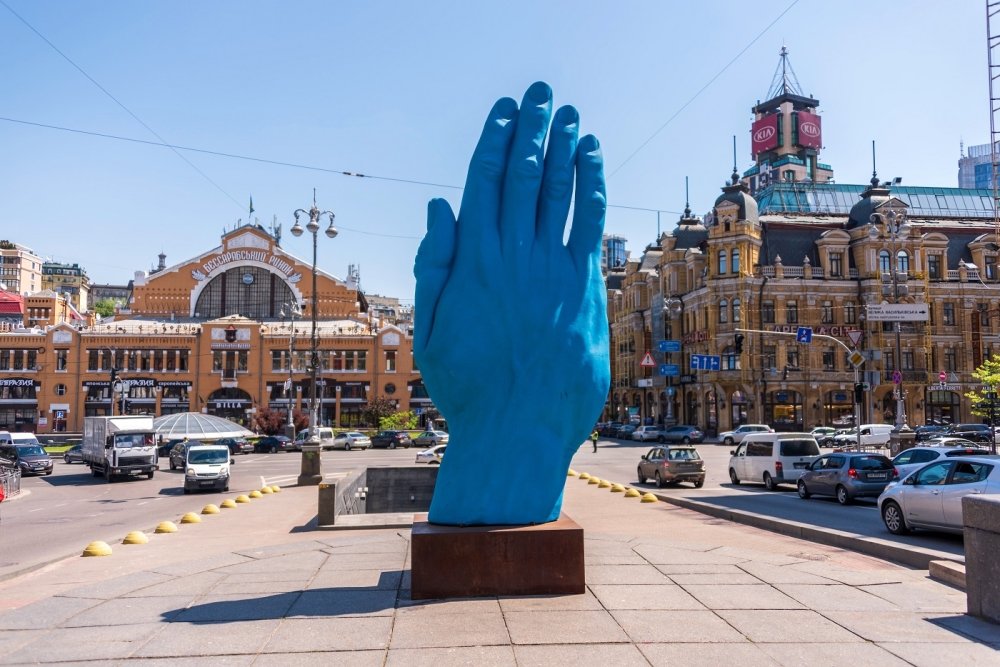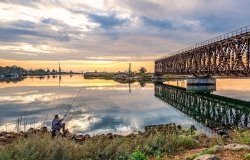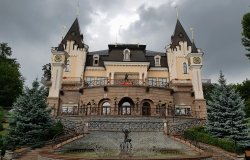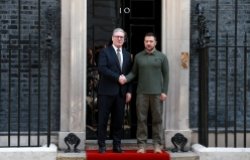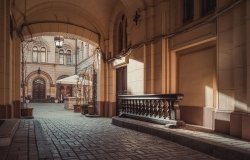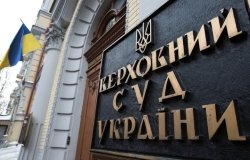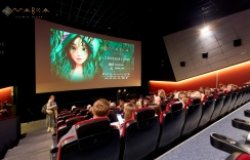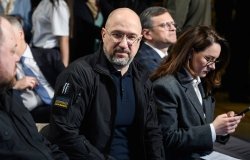
A blog of the Kennan Institute
Kyiv Biennial Goes Pan-European
Kyiv Biennial 2023, the fifth edition of the show highlighting the newest Ukrainian and international art, went pan-European this year. Beginning in Kyiv in October, it cascaded across the continent, with a series of openings into 2024 in Kyiv, Ivano-Frankivsk, Uzhhorod, Berlin, Warsaw, Lublin, Antwerp, and Vienna.
The founders—Kyiv’s Visual Culture Research Center with Austrian curators Hedwig Saxenhuber and Georg Schöllhammer—began the program as a response to the initial Russian seizure of eastern Ukraine in 2014. Since 2015, the festival has offered an international forum for art, dialogue, and politics through interdisciplinary presentations of seminars, socially engaged visual art, and political activism. Previous iterations integrated contemporary Ukrainian and international artists and audiences into a single conversation as an introductory gesture to create bridges for long-term individual and institutional relationships, bringing Ukraine closer to the European arts community. Imagined as a grassroot, artist-led initiative, the biennial became a way for the Ukrainian art community to turn away from Russian ambition and look to the West.
This year’s show explores the trauma unleashed by the Russian full-scale invasion of 2022. Its movable celebration brought together 120 artists, scholars, and activists to provide multiple perspectives on the displacement, decolonization, and psychological and ecological impacts of war. The organizers created an integrated program that was far more than just a biennial in exile.
The Berlin leg of the program series proved particularly noteworthy in light of that city’s place as arguably the most important center of contemporary art. Various art instillations, video sessions, seminars, lectures, and discussions spread out across the city at venues like the New Society for Visual Art, the Urban Culture Institute, Between Bridges, Prater Gallery, the Berlin outpost of the City Workshop based in Linz, Austria, and the Artspace Kreuzberg. Prominent and less-established artists from Germany and Ukraine (Ukrainians both remaining in Ukraine as well as in exile across Europe) offered dozens of events, attracting Berlin’s extensive arts community.
In addition to the various art exhibits, the Berlin shows included film screenings (such as Chornobyl 22 by Oleksiy Radynski); lectures (by Timothy Snyder and others); panel discussions (with Kateryna Iakovlenko, Yassin al-Haj Saleh, and Jan Tomasz Gross, among others); and musical performances (such as Heinali’s Kyiv Eternal). This wide range of offerings opened engagement between Ukrainian artists and their Berlin audiences.
Much of the Berlin programming between May and July focused on the question of time. What is the meaning of time at a moment when wars and instability of once secure political, social, and cultural regimes have brought the concept of sovereignty under attack? The art and accompanying discussions challenged peacetime notions of time with questions like: How different is the meaning of time during a military assault, occupation, displacement? How does our concept of time change when confronting a quagmire, a dead-end, a state of long-term suspended animation? How does the deprivation of a future-oriented imagination alter the sense of self? How does despair manifest itself? What is the meaning of “now” in the face of total uncertainty? Such queries were formulated and partially answered through artistic expression, which itself was disconnected from time.
None of the instillations at any of the Biennial’s Berlin stopover offer clear answers to such questions. But whatever the answers ultimately prove to be, this fifth Kyiv Biennial shows how they might be found through the artistic, intellectual, and cultural integration of Ukraine’s vibrant artistic community with that of Europe.
The opinions expressed in this article are those solely of the author and do not reflect the views of the Kennan Institute.
See our newest content first.
Subscribe to receive the latest analysis from Focus Ukraine.
About the Author

Blair A. Ruble
Former Wilson Center Vice President for Programs (2014-2017); Director of the Comparative Urban Studies Program/Urban Sustainability Laboratory (1992-2017); Director of the Kennan Institute for Advanced Russian Studies (1989-2012) and Director of the Program on Global Sustainability and Resilience (2012-2014)

Kennan Institute
The Kennan Institute is the premier US center for advanced research on Eurasia and the oldest and largest regional program at the Woodrow Wilson International Center for Scholars. The Kennan Institute is committed to improving American understanding of Russia, Ukraine, Central Asia, the South Caucasus, and the surrounding region though research and exchange. Read more


